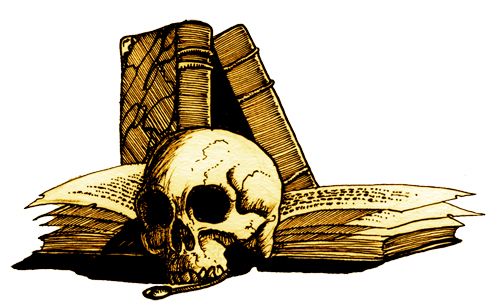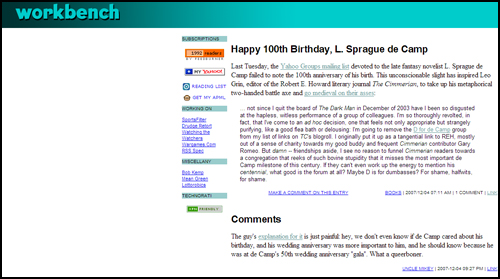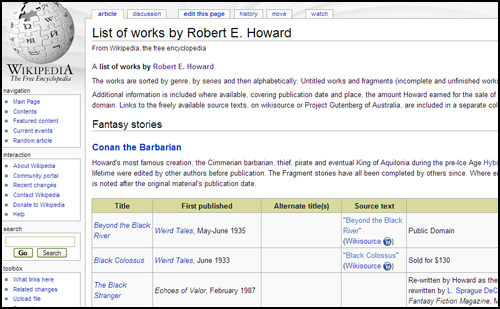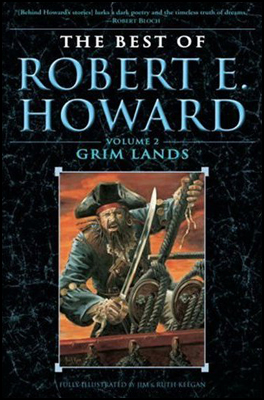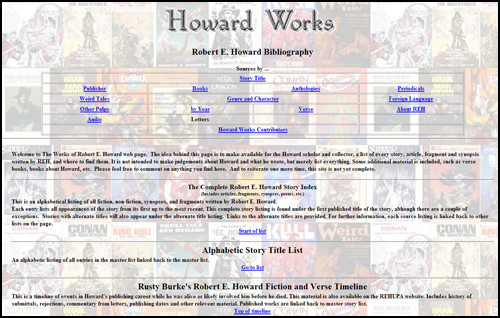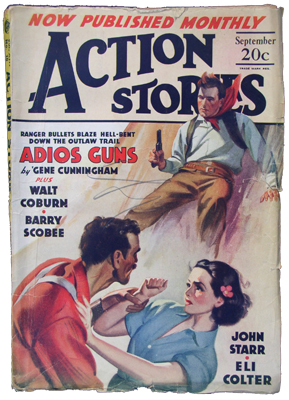
WHAT’S HOT
The “Lost Issue” of The Howard Review: Dennis describes the history of this issue in his auction, how it was an aborted issue that is only now being reprinted in REHupa, with only four copies reserved for the outside world. As such, the piece generated the same amount of interest that many of McHaney’s other items have, selling in the low hundreds ($257.07). A first printing mimeo (copy #2) of The Howard Review #1 recently went for $52. Surely there must be a subset of Howard collecting fandom developing, concentrated on the McHaney line of releases. There’s enough “lost issues” and “special editions” and “proof copies” to keep such an acquirer busy for a long time.
REH pulps: A September 1936 Action Stories went for $383.88, while a July 1936 Weird Tales with classic “Red Nails” cover went for $255.01. Both had lots of bids, 12 and 24 respectively, which demonstrates a healthy interest. Other pulps with absurd starting prices, however, didn’t get any bids. These are prices that were unheard of in the pre-eBay years, and they show that the market for collecting pulps is alive and well. Those who got in the hunt early have holdings that have appreciated many times over what their money would have done in most other investments.
What I’m waiting for is someone to digitize all of these pulps and make torrents out of them. When that happens (as it already has for comics and RPG rule books) will the prices go down for these? Not likely. They already are almost exclusively owned by collectors, and not general fans buying them only to read their contents.
Writer of the Dark: this old fandom warhorse from the 1980s is still going strong, selling yesterday for $190.63 in heavy bidding.
Lancer paperbacks: The rub on these was that they were a set of Lancers in exceptional condition. Bought when new, only read once, etc. Ended up going for the princely sum of $99.27. Other similar lots went for $78 and $76. Every time you hear a cash register ding, a de Campian gets his wings.
Eclectic REH chapbooks: it seems that anything REH that has just a little spin on it to make it “never-before-seen” or “different from other published versions” is catnip for Howard collectors. The latest is a little chapbook for an alternate version of “An Elkins Never Surrenders,” hardly one of the more famous tales in the Texan’s canon. Originally printed for the historic #200th mailing of REHupa last year, it was just sold at auction for an impressive $47.07. If you saw it up close, you would understand why I say that figure is “impressive.” People buy this sort of thing for the content, not the presentation, hypnotized by the “few-of-a-kind” siren song.
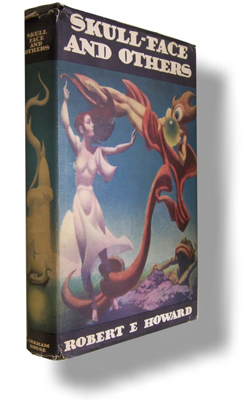
WHAT’S COLD
Arkham House Skull-Face and Others: One copy without dust jacket was advertised with a BUY IT NOW price of $250, but failed to sell. Another with a dust jacket had a BUY IT NOW price of $450, but ended up selling for a BEST OFFER price of only $300. Judging by past auctions, these prices are a bit soft compared to earlier in the year. One theory: the sellers are starting the auctions at minimum prices too high to spark the kind of furious bidding feeding frenzy that pushes prices up into the $500 range. Another theory: Christmas is a bad time to sell high-priced items like this, as most people have their time and money tied up in buying Christmas gifts for the family rather than choice high-ticket items for their own collections.
Complete set of the incomplete, horribly illustrated, error-ridddled Grant Conan editions: the seller wanted a minimum of $1500 for his set. He, um, didn’t get it.
Wandering Star series: This just keeps getting worse and worse. First Conan III never appears, then WS head honcho Marcelo doesn’t continue designing with Del Rey, then their website disappears, and now three of the books together (Conan I, Bran, and The Ultimate Triumph) have sold on eBay in unopened condition for $290 in heavy bidding. Set against that, we have a copy of Conan II that went for $159.99, but which was the result of a single bid for an inflated minimum price — in other words, a sucker got taken. A Bran went for a $65.00 BUY IT NOW bid, another for $49.99, more in line with current trends. These are terrible prices for what was supposed to be the “pay the high price, but treasure it for a lifetime” REH Library of Classics series. Don Herron was right (he’s almost always right) way back in 2004 in TC #1’s “Conan the Expensive”: they tried to do too much too slowly, and ended up becoming just another in a looooong like of broken, half-finished sets.
I was thinking that the announcement that Subterranean Press was continuing the Deluxe editions that Wandering Star let drop would have bolstered the price of the ones that were already in field, the logic being that, instead of dumping a forever-incomplete set, collectors could now look forward to completing it. But this makes me wonder if many collectors are considering the Subterraneans as faux, and hence will still consider the WS editions as incomplete and essentially damaged beyond hope. Might I remind you that the Del Rey’s are now and forever the first editions of Conan III, Kull, etc., a major selling point that Subterranean cannot claim. Subterranean Press might end up eating their shirt on this deal, depending on how much it’s costing them to get the rights, how many copies they intend to print, etc.
Comic book REH: whether it’s the Marvel Conans or the Cross Plains Comics abominations, it’s hard to even give them away these days. Last week, copy after copy went unsold by virtue of the seller attempting to eek out small margins in their minimum bid prices. They are in no position to bargain, and if they really want to sell the stuff they’ll have to price them at 99 cents and let the market decide what they are worth. Even then they may not sell, necessitating combining them into larger lots. Grim times for REH in comics.
Small Press Howard fiction: meaning the collections from outfits like Wildside. The superabundance of such books over the last few years has finally surpassed the arena’s ability to keep up. Readers have been making decisions over how many versions of the same story they need, and have been forgoing the rest of the options out there. It looks like the ones who have made out best are the Bisons and the Del Reys, leaving Wildside and lesser publishers getting the short end of the stick. I actually look forward to the time when simply publishing public domain Howard isn’t enough, when the quality and/or completeness of the contents matters more, as do the introductions, the font size, the construction of the books, the cover design, the illustrations (or refreshing lack thereof), etc. I don’t just want the stories for the umpteenth time, I want a good reading experience. The recent reprinting of The Hobbit in The History of the Hobbit set gets it right on all counts.
The Dark Man: I can’t remember seeing an REH-themed publication so completely in the dumps collecting-wise. It seems that in all of the magazine’s three major incarnations, the desire among fans to read and collect them is nil. Copy after copy fails to sell on eBay at the cover price, much less any sort of markup driven by time and demand. In the coming years, fans will get to argue over when was the moment that The Dark Man jumped the shark. Was it the format changes? The infamous publishing gaps of whole years? Their recent trend towards wreathing REH in the garland of Gay Studies? Probably it’s a combination of all of this and more.

WHAT TO WATCH
Arkham House Skull-Face and Others: The seller has it listed at a $450 minimum, which I believe will doom it to getting no bids. You can start low and let the bidders work their way up to those amounts, but starting that high usually doesn’t work.
Wandering Star Complete Conan of Cimmeria II: listed at $225. See above on why this won’t sell at this price without a major sucker coming along at unawares.
Dark Valley Destiny, paperback version: this yahoo is asking for $64.75 MINIMUM, for the paperback version of a book whose hardcover, signed, slipcased version typically sells for $20 or less. For $64.75 it better include a lock of de Camp’s hair or something.
Spanish versions of the Conan lancers: these are interesting. Priced at $25 the copy, will they sell to the ravenous REH collecting crowd ever on the lookout for the strange and rare? Are these editions in fact strange and rare among collectors who look for such things? I think they are plenty rare enough on this side of the pond to go for the minimums, at least. If there are a few guys out there with the same gleam in their eye, they could end up going for more. We’ll see.
The Acolyte #11: Ah, Francis Laney’s old mag, already up to $21.50 after 5 bids. I have a soft spot for this because my buddy Rah Hoffman (87 years old and counting) was a friend of Laney’s and contributed art and so forth to The Acolyte during it’s now-legendary run in the 1940s. In fact, Rah has an awesome photo taken at an army base where he was stationed while awaiting deployment to the European theater as a JAG officer during WWII. The photo was taken by an official Army photographer for publicity and print purposes, so it is exceptionally lit and razor sharp. It shows the base’s recreation room, with various soldiers talking, laughing, playing pool, etc. In the back, Rah planted himself at a table as if reading, and held up the subject of his concentration so that it is clearly visible in the ensuing photo. What was he reading? An issue of The Acolyte, of course.
That’s good old Rah for you — he has many, many stories about early fandom, filled with names we all know and revere, such as Robert Barlow, Charles Hornig, Emil Petaja, Hannes Bok, August Derleth, C. L. Moore, Clark Ashton Smith, and on and on. There’s much Howard material in some of those old magazines from the 1940s, stuff that the vast majority of modern Howard collectors — even the most knowledgeable — have no clue about. I’ve seen many examples, thanks to leisurely tours of Rah’s collection, the issues of which were acquired on the ground, at the time, from the original editors. It’s indescribably helpful to have him there at my side telling me all about the various names mentioned, people who to us are long forgotten fans, but to him were living and breathing friends. People who laid the groundwork of our field, but who now get precious little credit for the seminal work they did.
Looks like Darrell Schweitzer is selling this copy. I can’t agree with Darrell that Laney was “one of the most intelligent and articulate” fans of the period — that’s a typical mistake made by guys who know these characters only through browsing the fanzines and not through personal anecdotage. Laney was a fanboy through and through who made more than a few mistakes in his classic autobiographical take on the fandom arena, Ah, Sweet Idiocy! The doomed Paul Freehafer was the truly exceptional mind from the early LASFS group that included Hoffman, Laney, and so many others, but he died so young that his influence is felt more through the people he befriended like Rah than via a printed record of scholarship. Laney deserves props for pubbing The Acolyte and for being a mover and shaker in First Fandom, but most of his contributions are of interest to pure fans rather than scholars (if you thought the fandom fights of today seem petty and weird, check out the ones Laney describes in Ah, Sweet Idiocy! It used to be even worse than today). Compare what Laney was doing to what fans like Donald Sidney-Fryer and Glenn Lord did, and the gap in intelligence and articulateness is profound.

